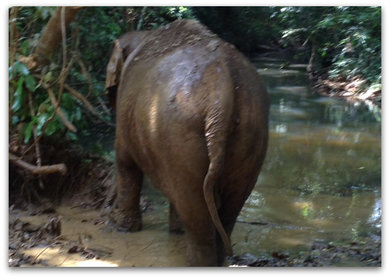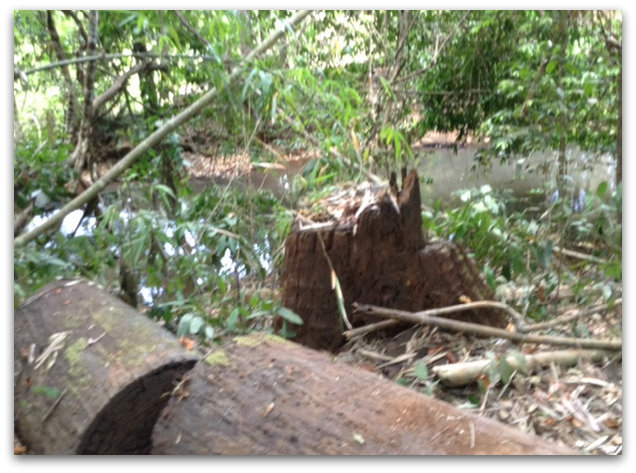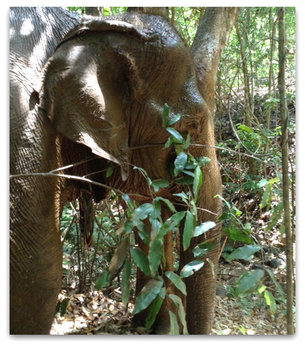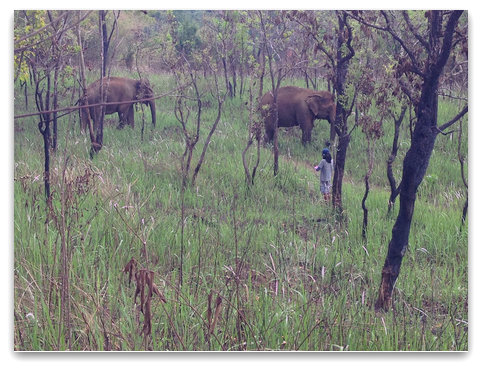My mom let me take a day off school at the end of March so I could go to Cambodia and see elephants. Thanks mom! We went for three days so we could pay a visit to the Mondulkiri forest and see the two retired elephants they have at a brand-new sanctuary there. I learned a lot about these two elephants and Khmer beliefs about these creatures. But I did not just learn about elephants. I learned about the wonderful job the group LEAF is doing to protect all of the animals who live in the rainforest.
LEAF (Local Environmental Awareness Foundation) (http://www.mondulkirisanctuary.org) is focused on educating Cambodian people and foreign visitors about animal welfare and conservation. Logging is also an important issue to LEAF. LEAF is a very newly formed organization. It is quite surprising to see how much a tiny organization can do. They are a non-governmental organization, so all of their money comes from donations and ecotourism. They are using the money they earn to create a sanctuary and eventually a wildlife rescue and rehabilitation center and to build houses for the people who volunteer to help.
LEAF (Local Environmental Awareness Foundation) (http://www.mondulkirisanctuary.org) is focused on educating Cambodian people and foreign visitors about animal welfare and conservation. Logging is also an important issue to LEAF. LEAF is a very newly formed organization. It is quite surprising to see how much a tiny organization can do. They are a non-governmental organization, so all of their money comes from donations and ecotourism. They are using the money they earn to create a sanctuary and eventually a wildlife rescue and rehabilitation center and to build houses for the people who volunteer to help.
Our guide, Ratana, and a volunteer named Jane took my mom, my aunty and me to the forest to hike. It was pretty hot that day, and I regretted bringing a giant backpack. Ratana was very knowledgeable because he had been very interested in nature since he was a child and he grew up in this area. He told us as we were walking through the forest that the Bunong people, a small minority tribe from this forest, owned this land and that LEAF was leasing it from them. LEAF is trying to lease some of the neighboring deforested farmlands as well. Some of the land nearby is owned by the government, and a lot of it was being illegally logged too. A bit later we crossed over a stream, and on the other side Ratana recognized the tracks of a giant Sambar deer, which is one of the oldest varieties of deer on the planet.
Probably the most interesting thing we saw on that walk was a very rare species of bug. On the side of a small tree, my mom noticed lots of fluffy white things which looked like flowers. She asked Ratana what it was, and he said it was a small bug. My mom asked what type, but Ratana said it was so rare that the Khmer (the main group in Cambodia) people don’t even have a name for it. The little bugs started jumping around, and my mom and I stared at this amazing and beautiful bug. The bugs were very interesting. When they jumped, they recoiled and then shot out, like a rubber band. Ratana did not seem that interested in the bugs, he just kept on walking. My mom did some research later and it turns out that the bugs are flatid planthopper nymphs, which are super rare for this forest and hardly ever seen by human eyes.
LEAF is doing a great job for such a new organization, and the thing it is focusing on is rehabilitating the ecosystem for the animals that live in the area. Most of the animals who live in Mondulkiri are migratory, which means they move around to get food and water. And because a lot of the forest that the animals use to migrate has been destroyed by loggers, the animals are having a hard time getting around. But LEAF is trying to stop that. They are rebuilding the main migration corridor in the forest. They are first planting fruit trees, because they grow very quickly. The trees will provide more food for the animals, thus raising the population. And when the forest is healthy enough, LEAF is going to replant the native trees.

The reason most of the forest here is being destroyed is illegal logging, mostly by foreign companies. A worker at LEAF named Scott told us a lot about the logging situation. It is illegal to cut down trees in the forest, but as we were walking we passed by lots of stumps. Cambodia is extremely poor, and for a lot of people in this area, logging is a way to earn money. Scott also told us most of the wood cut down is smuggled into Vietnam, and then goes to China. Illegal loggers sometimes work with people in the government, which is why it is so hard to stop them. A logging company had built the road that we came on to Mondulkiri, but we didn’t even know that. The loggers get away with taking the logs in their trucks, because they “own” the road and so the police don’t stop them.
We finally arrived at the clearing where the elephants were hanging out with their mahouts. The elephants are named Cherpil and Chelot. Chelot is 67, and Cherpil is 70. These two old ladies are great friends and they did everything together. If one got alarmed, the other one would follow behind. They both like the same plants, and where one went, the other followed. We just enjoyed watching the elephants doing what they like to do.
Both elephants did not have the best looking backs, though. They we curved upward in an odd position. We asked Ratana why, and he said it was because before LEAF rescued them, they worked as riding elephants for tourists. Everyday they had to walk two hours to the tourist camp with big heavy elephant saddles on their backs. If they stopped on the way to eat, which elephants like to do, they were beaten. They gave rides to tourists all day, and only got two hours’ break to eat, not nearly enough time, as wild elephants eat almost every waking hour.
They also sometimes worked for illegal loggers. These two elephants (above R) are owned by many different families, so they were worked a lot to do many different things. That’s where LEAF stepped in. LEAF pays the families to not work their elephants at all, so the elephants could retire. LEAF pays villagers to not do things like this. They provide food and power to some villagers, asking them only not to hunt or illegally log.
 Chelot’s mud bath. You can see her hairless tail.
Chelot’s mud bath. You can see her hairless tail. I noticed that Chelot was missing the hairs on her tail. I asked Ratana why, and he said because the Khmer people believe if you make a bracelet or ring out of elephant hair, it’s supposed to be good for you and bring good luck. He said after the hairs were pulled out by the roots, it was bleeding a lot. Chelot was not as unlucky as some elephants, who have their entire tail cut off, and are sometimes even killed. My aunt now knows never to buy elephant hair rings and bracelets. When she was young and lived in India, she sometimes bought jewelry made with elephant hair, not knowing the truth behind it. My mom asked why the elephants did not have any children, because in the wild elephants of their age would have had about three calves. Ratana said that the Khmer people believe that if an elephant has a baby, one of the human babies in the village will die. So working elephants are restricted from breeding.
After our conversation with Ratana, we walked down to the river to bathe the elephants. The elephants didn’t want to get into the water but just splashed in the mud a lot. I was eating my lunch while the elephants were in the mud, which is a very bad idea. My fried rice ended up with mud in it. The mahouts kept trying to get the elephants into the water, I think because they did not want to ride the elephants’ muddy backs. After a while, the elephants walked out of the mud and into the jungle, with their mahouts following them.
After our conversation with Ratana, we walked down to the river to bathe the elephants. The elephants didn’t want to get into the water but just splashed in the mud a lot. I was eating my lunch while the elephants were in the mud, which is a very bad idea. My fried rice ended up with mud in it. The mahouts kept trying to get the elephants into the water, I think because they did not want to ride the elephants’ muddy backs. After a while, the elephants walked out of the mud and into the jungle, with their mahouts following them.
 Zero carbon footprint power generator
Zero carbon footprint power generator We walked over to a small waterfall without the elephants, and Scott showed us the hydroelectric generator built by a local man that has a zero carbon footprint. LEAF has created lots of eco-friendly energy generators, which they use to power villages and houses for the volunteers to stay in. I found that very interesting.
It was time to leave, so we headed back to the clearing, and Chelot and Cherpil were there, grazing. I did some sketches of the two of them while we were enjoying the fresh air and breeze of the jungle. We said our goodbyes to them, and started our hike back.
I think LEAF is doing an absolutely amazing job protecting the wildlife of the Mondulkiri forest. If you ever visit Cambodia, I highly recommend coming here and enjoy seeing the forest and the animals. I would like to thank my mom for taking me to such a fun and interesting place, and I’d like to thank LEAF, for doing such a great job protecting the forest. I will come back next year when I am being homeschooled, and I will volunteer at LEAF.
LEAF Website: http://www.mondulkirisanctuary.org/














 RSS Feed
RSS Feed


